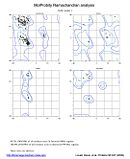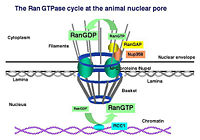Sandbox Reserved 485
From Proteopedia
| This Sandbox is Reserved from 13/03/2012, through 01/06/2012 for use in the course "Proteins and Molecular Mechanisms" taught by Robert B. Rose at the North Carolina State University, Raleigh, NC USA. This reservation includes Sandbox Reserved 451 through Sandbox Reserved 500. | |||||||
To get started:
More help: Help:Editing For more help, look at this link: http://www.proteopedia.org/wiki/index.php/Help:Getting_Started_in_Proteopedia
Ran-GDP (Ras related nuclear protein)
IntroductionRas related nuclear protein, known as the Ran protein, is the most abundant small GTPase in the cell and serves a variety of key roles in cellular regulation and protein transport. Ran is a binding protein that is a subset of the RAS superfamily that actively binds between GDP and GTP to regulate the import and export of RNA molecules and cytoplasmic material. The Ran protein also plays a key role during interphase and mitosis as the cell progresses through the cell cycle and DNA is synthesized. The majority of the Ran protein is located within the nucleus of eukaryotic cells and interacts with a a variety of proteins due to its diverse uses.[1] StructureThe Ran protein is a small binding protein that consists of 221 residues. The consists of a mixture of eleven, 70-residue alpha-helices and twelve, 55-residue beta-sheets. The Ran protein is made up of two asymmetric units, Chain A and Chain B. Each unit binds to a Mg2+ and a GDP. X-ray crystallography, examined at 2.3A, produced a Ramachandran plot that determined the crystal structure of Ran bound GDP and Mg2+. The crystal structure showed that the Ran protein shares a high resemblance to the G-domain of the Ras protein. However significant discrepancies were observed in the GDP and Mg2+ binding sites, suggesting that the binding of GTP results in significant conformational changes to the protein.[2] Ran proteins contain a cis-glutamine which is responsible for positioning nucleophilic water, which in turn activaes GTPase activity. Along with the consistencies observed in the G-domain, an extended chain and an a-helix were observed on the carboxy terminus while a compliant amino-terminal stretch and an acidic tail were observed on the amino-terminal end. [3] In addition to the Ran protein binding to GTP, Ran also binds to Ran-binding proteins. Ran binding proteins serves as a cofactor in regulating the export and import processes from and to the nucleus and cytoplasm. Ran binding proteins contain a discrete Ran binding domain(RBD). The Ran binding proteins consists of a single RBD with short extensions at the N and C termini. The RBD averages 170 residues. Ten of these residues are highly conserved as the charged hydrophilic residues act as binding sites to the contiguous on the Ran protein. These are observed throughout mammalian, yeast and C. elegans. An example of this reaction is Ran interacting with Ran binding proteins that are components of the nuclear pore complex, Nup 153 on the nuclear end and Nup 358 on the cytoplasmic end. Using x-ray crystallography, refined with crystal engineering revealed that these nucleoporins contain distinct Ran-binding zinc finger domains within the switch 1 region that complex with the Ran protein via H-bonds at Lys38 and Thr42.[4]
Mechanism of ActionRan Cycle: Import and ExportThe Ran cycle plays a major function in translocating cargo such as RNA and proteins from and to the cytoplasm and nucleus. Cargo that is imported are typically proteins that are synthesized in the cytoplasm but function in the nucleus. A receptor protein known as an importin recognizes and binds to the nuclear localization signal, NLS, located on the cytoplasmic cargo. Importin-NLS protein complex is then able to be transported from the cytoplasm through the nuclear pore complex into the nucleus. Once inside the nucleus, the importin binds to Ran-GTP, allowing the release of the protein from the importin. The Ran-GTP-importin complex migrates back through the nuclear pore complex to release the importin back into the cytosplasm for reuse as Ran-GTP is hydrolyzed to Ran-GDP. The export of cargo into the cytoplasm typically involves RNA molecules that are synthesized in the nucleus but function in the cytoplasm. The receptor protein known as exportin binds to Ran-GTP within the nucleus to promote the recognition and binding of exportin to the nuclear export signals, NES, the is located on the RNA bound cargo protein. The exportin then mediates the transport of the complex through the nuclear pores The key to the import and export of cargo material is dependent on the concentration of Ran-GTP. The concentration of Ran-GTP is maintained by guanine-nucleotide exchange factor, GEF, in the nucleus and a GTPase activating protein, GAP, in the cytosol. Cellular signals indicate the course of the Ran cycle and is especially significant while entering mitosis. [5] Regulation of MitosisRan also serves a variety of other functions such as mediating DNA synthesis and advancements through a cell cycle. During prophase the RanGTP-RanGDP gradient from the nucleus to cytoplasm is high, resulting in th ebreakdown of the nuclear envelope. Nup358 and other Ran associated proteins are directed to the kinetochores to directthe attachment of spindle fibers to chromosomes. RanGTP further activates the assembly of the spindle by releasing and activating the spindle assembly factors, NuMA and TPX2. During telophase the RanGTP is hydrolyzed to reform the daughter nuclei's nuclear envelope. [6] Ran regulates these functions by directing the formation and organization of the microtubule complex. Ran-GTP promotes spindle assembly and the spindle fiber’s attachment to the chromosome. Ran is also involved in activating T cells and the reassembly of the nuclear envelope during mitosis. Possible ApplicationsIt is obvious the importance Ran plays within the cell cycle. Defective Ran protein results in irregular reformation of the nuclear envelope, chromosome assembly and microtubule formation. Within the nucleus, malfunctions pertaining to factors associated with specific functions such as splicing and DNA replication These misregulations can result in a wide range of disorders such as infertility, severe tissue damage in immunodeficient disorders such as Celiac's disease[7] or X-linked neurodegenerative diseases such as Kennedy's disease. Further research is being conducted by Wisconsin Alumni Research Foundation(WARF) to design an inhibitor specific to Ran. Their research hopes to fully understand Ran’s mechanisms and regulatory measures in nuclear transport, mitotic spindle assembly and translational regulation. [8] References
|



